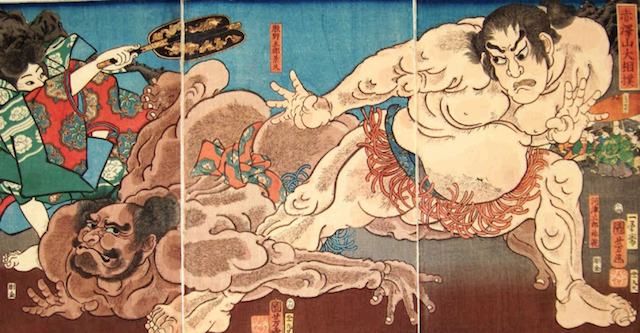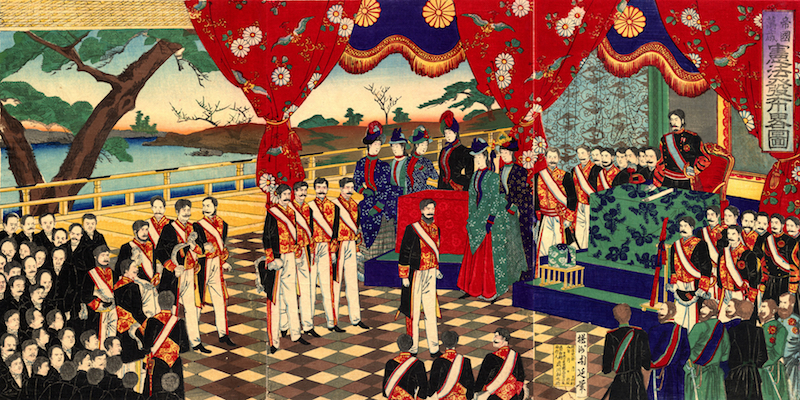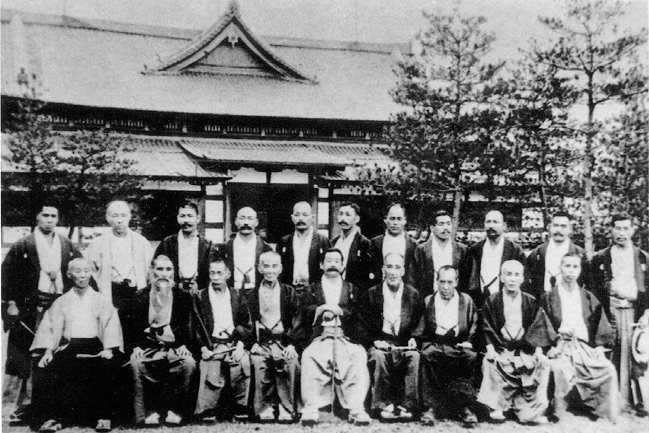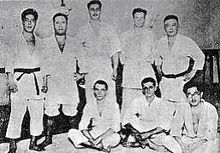- ETYMOLOGY
Jūjutsu (n.)
The word 柔術 (jūjutsu) is composed of two kanji characters. 柔 (jū) “softness, gentleness” and 術 (jutsu) “art, skill”. It was first transliterated to roman characters around 1875. For phonetic reasons, the romanization of this japanse word was mistakenly done as jiu-jitsu instead of jūjutsu. This improper spelling became popular around the world and remains widely used.
THE ORIGIN OF JŪJUTSU
“As to the origin and native land of jūjutsu, there are several opinions, but they are found to be mere assumptions based on narratives relating to the founding of certain schools, or some incidental records or illustrations found in the ancient manuscripts not only in Japan but in China, Persia, Germany, and Egypt. There is no record by which the origins of jūjutsu can be definitely established. It would, however, be rational to assume that ever since the creation, with the instinct of self-preservation, man has had to fight for existence, and was inspired to develop an art or skill to implement the body mechanism for this purpose. In such efforts, the development may have taken various courses according to the condition of life or tribal circumstance, but the object and mechanics of the body being common, the results could not have been so very different from each other. No doubt this is the reason for finding records relating to the practice of arts similar to jūjutsu in various parts of the world, and also for the lack of records of its origins.”
–Sensei G. Koizumi, Kodokan 7th Dan
BIRTH OF JŪJUTSU
Jūjutsu (also known as jiu-jitsu, jujitsu) techniques did not evolve from one source or root; instead, they have multiple roots and traveled through many countries before arriving in Japan.
Even though the true origins of jūjutsu techniques are impossible to accurately be established, elements of the art can be traced back to the beginnings of recorded history. A Babylonian copper stand (see photo below), for example, dating from the third Millennium BC, shows two men engaged in a grappling position that is common in jūjutsu. Both men are trying to unbalance each other by controlling the hip.
.jpg)
JAPAN
The ‘Nihon Shoki,’ “The Chronicle of Japan,” a book of classical Japanese history compiled by imperial command under the supervision of Prince Toneri in 720 AD, refers to a tournament called ‘Chikara-Kurabe,’ the contest of strength, which was held in the 7th year of the Emperor Suinin, 230 BC. Some historians regard this as the beginning of Sumo or Japanese wrestling, which has something in common with jūjutsu.

Empty hand techniques were part of Japanese warriors’ training during the Heian period (794 – 1185 AD). During this time Buddhism, Taoism and other Chinese influences were at their height. These Chinese belief systems formed the philosophical base for the art of jūjutsu. The jūjutsu concept of soft overcoming hard, yielding rather than resisting, was taken directly from Chinese Classics such as the Tao Te Ching. The connection between this concept and ancient fighting techniques culminates in a unique fighting system called jūjutsu.
Even though the early history of jūjutsu is often difficult to be definitively ascertained, it is a fact that the Japanese samurai warriors were responsible for organizing a highly sophisticated martial art called jūjutsu, which was developed in Japan during the Feudal period.
THE ART OF THE SAMURAI
The period of Japanese history between the 8th and 16th centuries was one of constant civil war, and many systems of fighting were utilized, practiced, and perfected on the battlefield. Training was mostly focused on overcoming armored and armed opponents.
The history of the art during this time is uncertain because teachers kept everything secret in order not to give their enemies an advantage. However, the evolutionary process of jūjutsu at that time was highly realistic since the techniques were constantly tested and perfected in combat. The warrior caste clearly had a need for some empty-hand techniques because there was always the possibility of losing one’s weapon or being caught without one. Thus, even though empty-hand combat was a distinctly secondary skill to an armed warrior, some development of unarmed combative skill occurred in these old martial systems. This was the initial seed from which a complete approach to unarmed combat was born.
EDO PERIOD
In approximately 1603, Japan came to a fairly peaceful period following the formation of the Tokugawa military government by Tokugawa Ieyasu. During this time (1603-1868), the feudal civil wars that had plagued Japan for centuries started to disappear. However, following the adage “living in peace, but remembering war,” the practice of martial arts continued to spread. The traditions of classical bujūtsu (martial arts) required that samurais should learn a method of self-defense for those situations where weapons could not be used.
Armored skills of fighting began to yield to weaponless styles which incorporated many of the striking and grappling techniques of the older styles. During this time the emphasis in combat instruction changed from battlefield art to personal protection in a civilian setting. Grappling techniques for ground fighting were greatly explored and developed during this period.
During feudal times, an assortment of names were utilized to describe empty hand combat systems including Yawara, Taijūtsu, Torite, Kenpo, Hakuda, and Kogusoku. Later, all these styles would come to be known as kōryu (old school) jūjutsu. It has been estimated that over 500 recorded systems of jūjutsu were practiced in Japan during its golden age from 1680 to 1850.
MEIJI RESTORATION
In 1868, the Meiji Restoration of the Emperor replaced the feudal military regime established by Tokugawa Ieyasu in 1603. During this time the samurai class, which included approximately two million individuals, and its ways were abolished from japanese society.

With the arrival of Admiral Perry’ fleet in 1853 and the demonstration of great western military prowess, the Japanese people had become disenchanted with their bujutsu (military arts). Consequently, the “old ways” were out of fashion and jūjutsu was looked down upon. Many instructors were no longer upholding the values of the Bushidō (way of the warrior) Code. The Bushidō provided ethical guidelines to the samurai warriors, who were virtually the only practitioners of jūjutsu prior to the Meiji Restoration. Without its influence, several practitioners became engaged in prize fighting, drinking, gambling and uncivil behavior.
Jūjutsu was originally an art designed for combat, but after the abolition of the feudal system in Japan, certain modifications needed to be made to the art in order to make it suitable for modern times. Even though jūjutsu was viewed as a complete method of self-defense, there was an evident lack of discipline and moral education in the practice of the art after the abolition of the samurai class.
JIGORŌ KANŌ
With the profound cultural and social transformations of the Meiji era, there was an urgent need for associating the practice of jūjutsu with a positive way of life adapted to modern times. For this reason, Jigorō Kanō (1860-1938), a highly educated man, and a practitioner of jūjutsu, developed his own approach to teaching the art in the late 1800s, called Kano Jūjutsu and later, Kōdōkan Jūdō.
Due to the negative connotation that the word jūjutsu had developed, Jigoro Kano decided to use the term jūdō instead. By replacing the second character jutsu, which was widely associated with the antiquated japanese military arts (bujūtsu), with the character dō, which means way or doctrine, Kano attempted to give the art a deeper spiritual meaning. In this rebranding effort he did not coin a new word to describe his method because he recognized that he was not creating a different martial art but rather an innovative and modernized teaching methodology. The term jūdō had been used as early as 1724 by members of Jikishin Ryu.
In addition to a strict code of ethics, Kano’s method was based on kata (technical training) and randori (sparring). Kanos’s approach prioritized physical, moral and cultural education in a safe and positive training environment.
The Kōdōkan Jūdō teaching methodology eventually replaced the old jūjutsu methods. It was adopted in the public school system, military and law enforcement training.
Kano was responsible for jūjutsu/jūdō regaining its prestige in Japan. As an educated man he emphasized etiquette, discipline, respect and morality as part of training.

Kano’s pedagogy was based on three principal objectives: self defense education (shobuho), physical education (reshinho) and moral education (shushinho).
In the 1920s, Kano became increasingly concerned that the growth of competitions might lead to a retrograde form of contest jūdo, as jūjutsu was before the Kōdōkan was established. He worried that a “winning at any cost” mentality would overshadow the higher moral aims of jūdo. Moreover, he felt that an exaggerated focus on winning contests would take away from the combat effectiveness of the art. For this reason, Kano started, among other measures, to de-emphasize groundwork in Kōdōkan Jūdō. His belief was that even though grappling techniques were extremely useful in challenge matches, they were not as relevant for self defense, especially given the possibility of multiple opponents. He believed that throwing and striking techniques should be learned first and foremost. Grappling was to be mastered as well but not exclusively.
_in_an_agricultural_school.jpg)
Time proved that Jigorō Kano’s concerns were well founded. A few decades later, the tremendous growth of sportive competitions regulated judo and eventually limited its combat effectiveness. After World War II, many US soldiers, while stationed in Japan, were exposed to the sport of jūdō and brought it back to America with them. The sport of jūdō quickly gained popularity around the globe and consequently the self defense aspect of the art was gradually forgotten.
JŪJUTSU IN THE WEST
Jūjutsu arrived in the west in the latter part of the 19th century and quickly became a huge craze. Practitioners from all over Japan migrated to Europe and the Americas in order to meet the great demand that existed for jūjutsu instruction. From military units to law enforcement agencies, from businessmen to housewives, everybody wanted to learn the Japanese art of self defense. The popularity of jūjutsu was established through challenge matches and public fights. Jūjutsu representatives from Japan would face wrestlers and boxers to prove the superiority of the Japanese style. Japanese fighters, who were usually smaller than their opponents, lauded jūjutsu as a scientific fighting system that allowed a small person to overcome a bigger and stronger opponent by utilizing principles such as leverage and yielding flexibility. Jūjutsu experts like Yukio Tani, Sada Uyenishi, Taro Miyaki, Mitsuyo Maeda, Tokugoru Ito, Soshihiro Satake, Akitaro Ono and Geo Omori traveled the world to promote jūjutsu through prize fights and demonstrations that took place in theatres, stadiums, circuses and fairs located in almost every corner of the Western Hemisphere.
JŪJUTSU IN BRAZIL

Jūjutsu gained notoriety in Brazil around 1914 with the arrival of Mitsuyo Maeda, who was known by the ring name Conde Koma. Even though a few other Japanese teachers had taught in Brazil before, Maeda had the greatest impact. He was born in 1878 and started learning jūdō at the Kōdōkan in 1897. He trained at Jigoro Kano’s academy under the legendary Sakujiro Yokoyama. In the early 1900s, after being in the United States as an official representative of the Kodokan, he broke away and traveled the world participating in several challenge matches in many countries including England, Spain, United States, Cuba, Mexico and finally Brazil. During this time Maeda stopped using the term jūdo and reverted to the old generic name jūjutsu, spelled as jiu-jitsu. This occurred because the name jiu-jitsu was more popular outside of Japan at that time. In addition, he was fighting for money and even participating in worked matches, which was a serious breach of Jigorō Kano’s philosophy. Kano believed that challenge matches were only to be performed with the objective of demonstrating the effectiveness of jūdō and never for monetary gain.
IRMÃOS GRACIE
In 1914, Maeda traveled to Brazil to teach the art and participate in prize fighting events. In the northern state of Pará, he became acquainted with Gastão Gracie, a local businessman and fight promoter. After watching one of Maeda’s exhibitions in the “American Circus”, of which his father was a partner, Gastão’s oldest son Carlos decided to start training at Maeda’s academy. Under the tutelage of Maeda’s best student Jacinto Ferro, Carlos trained for a few years until eventually moving with his family to Rio de Janeiro in 1922. According to Carlos, he did not practice jūjutsu again until 1928 when a training partner from Maeda’s academy in Belém, Donato Pires dos Reis, invited him to be his assistant in teaching jūjutsu at the police academy in Belo Horizonte. Carlos took the oportunity and eventually became the lead instructor when Donato left.
On September 7th, 1930, Donato was back in Rio where he opened a jūjutsu academy called “Academia de Jiu-Jitsu”. Carlos and his brother George Gracie were invited to assist him in this academy. Their other brothers, including youngest brother Helio, who was 16, joined them and started to train as well. Carlos, Oswaldo, Gastão Jr., George and Helio, known in Brazil as “Irmãos Gracie (Gracie Brothers), eventually had a falling out with Donato who moved away from Rio. The Gracie brothers kept the academy and in 1932 they started referring to it as the “Academia Gracie de Jiu-Jitsu” freely translated as Gracie Academy of Jiu-Jitsu.
Even without much formal education, Carlos diligently studied, in addition to jūjutsu, many different subjects including nutrition, spirituality, exercise and natural hygiene. He read every book that he could find on all these subjects. A philosopher in nature, Carlos was the “thinker of the clan” as a famous journalist of the time would call him, and would always provide invaluable advice to his brothers on all areas of life. In addition to being the first Gracie to learn, teach and fight for the art of jūjutsu, his great wisdom and marketing acumen were a major guiding force in the preservation and promotion of the art in Brazil.
In order to prove the effectiveness of the Japanese art of jūjutsu, the original Gracie brothers, most notably George and Helio, participated in challenge fights against wrestlers, boxers and capoeiras in Brazil. Using the tried and true formula of their Japanese predecessors, their challenge fights were often against bigger and stronger opponents in order to prove that it was possible for a small person to defend against any attacker. They also faced Japanese judo/jūjutsu black belts to assert their technique as on par with the Japanese. George was a more aggressive and entertaining fighter while Hélio developed a more defensive style specifically designed to resist stronger and heavier opponents.
The Gracie brothers would eventually separate and seek different paths. Carlos and Helio, however, were inseparable. Helio saw Carlos, who was eleven years older, as a father figure and listened carefully to his every advice. They were both idealists and saw themselves, above all, as teachers of an art that could transform lives for the better. Their academy quickly became highly successful and well attended. George, on the other hand, became a professional fighter accepting matches throughout Brazil. Carlos and Helio did not like the emphasis that promoters were placing on entertainment and money. They refused to accept fights that were decided on subjective criteria such as points and judges decisions. They also strongly opposed fake fights with predetermined outcomes, which had become the norm. Staying true to their original ideals, they passionately dedicated themselves to teaching and preserving jūjutsu.
Meanwhile in Japan with the passing of Jigoro Kano and the lure of becoming an olympic sport, jūdō slowly shifted from being a complete fighting system to a competitive sport focusing on throws with limited ground grappling and almost no emphasis on striking techniques. New rules and regulations, designed to make matches more entertaining, eventually modified the way the art was taught.
Refusing to accept any imposition by Japanese authorities who seeked to convert all jūjutsu schools into jūdō, the Gracie brothers felt that the art should continue to be taught as a self defense method and not a sport. Carlos and Hélio believed at the time that the sport of jūdō was being promoted worldwide by the Japanese government with the purpose of hiding the complete nature of jūjutsu from foreigners. According to their theory, the increased immigration of westerners into Japan during the Meiji period caused nationalistic jūjutsu masters, who were very secretive with regard to their techniques, to worry about the possibility of foreigners, generally bigger and stronger than the Japanese, learning complete jūjutsu. However, the drastic mutation of jūdō into a pure sport rather than a complete self defense system most likely occurred as a natural consequence of practitioners exclusively focusing on the rules of the sport in order to excel in tournaments. Ironically, the same thing would take place in Brazil after the creation of the first BJJ federation in the 1960’s, originally known as “Federação de Jiu-Jitsu da Guanabara”.
In 1952, Carlos and Helio inaugurated a state of the art academy in downtown Rio. Located in the 17th and 18th floors of a high profile commercial building, the luxurious facility quickly became very successful. Under the mentorship of Carlos and Helio, a team of professors was formed to meet the great demand that existed. Carlson Gracie, João Alberto Barreto, Robson Gracie, Hélio Vígio and Armando Wriedt, together with Pedro Hemeterio who taught in São Paulo, formed the first group of practitioners to receive the navy belt and the coveted professor’s diploma. At the time the Gracie Brothers wore the navy belt in order to distinguish themselves from sport judo instructors who wore black belts.The downtown academy was the most well designed, organized and managed academy of its generation.
Carlos and Helio’s main objective was to demonstrate that a small person could neutralize superior strength and athleticism through the knowledge of jūjutsu. It is undeniable that Hélio, who weighed approximately 143 lbs, accomplished some astonishing feats in the ring against high profile opponents such as German American wrestler Fred Ebert (192 lbs.), world wrestling champion Wladek Zybsko, (234 lbs.) and heavyweight jūdō legend Masahiko Kimura (200 lbs.).Throughout his life, however, Hélio Gracie always repeated that he did not consider himself a professional fighter since he never fought with the objective of making money or proving himself. His greatest mission was to raise his students’ confidence in the techniques of jūjutsu. For this purpose, he continuously perfected a teaching method, which allowed for any person, even those not athletically gifted, to learn the fundamentals of self defense in 40 private lessons. His students included men, women, children from all walks of life. He also developed specialized programs for law enforcement and military personnel. Some of the most important people in the country became his students, including the governor of his state and a future president of Brazil.
Carlos and Hélio Gracie became legendary jūjutsu grandmasters whose lifetime dedication to the art positively impacted the lives of thousands of individuals from around the globe. With the creation of the original UFC by Helio’s oldest son in 1993, Carlos and Hélio gained international acclaim for their dedication to the preservation and promotion of jūjutsu.


